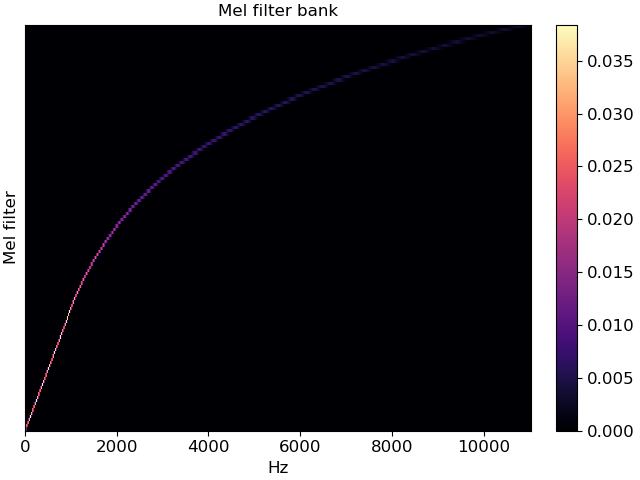Caution
You're reading an old version of this documentation. If you want up-to-date information, please have a look at 0.10.2.
librosa.filters.mel
- librosa.filters.mel(sr, n_fft, n_mels=128, fmin=0.0, fmax=None, htk=False, norm='slaney', dtype=<class 'numpy.float32'>)[source]
Create a Mel filter-bank.
This produces a linear transformation matrix to project FFT bins onto Mel-frequency bins.
- Parameters:
- srnumber > 0 [scalar]
sampling rate of the incoming signal
- n_fftint > 0 [scalar]
number of FFT components
- n_melsint > 0 [scalar]
number of Mel bands to generate
- fminfloat >= 0 [scalar]
lowest frequency (in Hz)
- fmaxfloat >= 0 [scalar]
highest frequency (in Hz). If None, use
fmax = sr / 2.0- htkbool [scalar]
use HTK formula instead of Slaney
- norm{None, ‘slaney’, or number} [scalar]
If ‘slaney’, divide the triangular mel weights by the width of the mel band (area normalization).
If numeric, use
librosa.util.normalizeto normalize each filter by to unit l_p norm. Seelibrosa.util.normalizefor a full description of supported norm values (including +-np.inf).Otherwise, leave all the triangles aiming for a peak value of 1.0
- dtypenp.dtype
The data type of the output basis. By default, uses 32-bit (single-precision) floating point.
- Returns:
- Mnp.ndarray [shape=(n_mels, 1 + n_fft/2)]
Mel transform matrix
See also
Notes
This function caches at level 10.
Examples
>>> melfb = librosa.filters.mel(22050, 2048) >>> melfb array([[ 0. , 0.016, ..., 0. , 0. ], [ 0. , 0. , ..., 0. , 0. ], ..., [ 0. , 0. , ..., 0. , 0. ], [ 0. , 0. , ..., 0. , 0. ]])
Clip the maximum frequency to 8KHz
>>> librosa.filters.mel(22050, 2048, fmax=8000) array([[ 0. , 0.02, ..., 0. , 0. ], [ 0. , 0. , ..., 0. , 0. ], ..., [ 0. , 0. , ..., 0. , 0. ], [ 0. , 0. , ..., 0. , 0. ]])
>>> import matplotlib.pyplot as plt >>> fig, ax = plt.subplots() >>> img = librosa.display.specshow(melfb, x_axis='linear', ax=ax) >>> ax.set(ylabel='Mel filter', title='Mel filter bank') >>> fig.colorbar(img, ax=ax)
